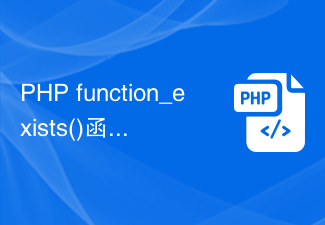 Backend Development
Backend Development PHP Tutorial
PHP Tutorial Detailed explanation of the role of reference (& symbol) in php_PHP tutorial
Detailed explanation of the role of reference (& symbol) in php_PHP tutorialPHP reference (that is, adding an ampersand in front of a variable, function, object, etc.)
Quotation in PHP means: different names access the same variable content.
and C language The pointers in are different. The pointer in C language stores the address where the content of the variable is stored in memory
Variable reference
PHP’s reference allows you to use two variables to point to the same content
$a="ABC";
$b =&$a;
echo $a;//Output here: ABC
echo $b;//Output here :ABC
$b="EFG";
echo $a;//The value of $a here becomes EFG, so EFG is output
echo $b;//EFG is output here
?>
Function call by address
I won’t go into details about the call by address. Below is the code directly.
function test(&$a)
{
$a =$a+100;
}
$b=1;
echo $b;//Output 1
test($b); //What $b is passed to the function here is actually $ The memory address where the variable content of b is located. You can change the value of $b by changing the value of $a in the function
echo "
";
echo $b;//output 101
It should be noted that if you test(1); here, an error will occur. Think about the reason yourself
The reference return of the function
Look at the code first
function &test ()
{
static $b=0;//Declare a static variable
$b=$b+1;
echo $b;
return $b;
}
$a=test();//This statement will output the value of $b as 1
$a=5;
$a=test();//This statement will Output the value of $b as 2
$a=&test();//This statement will output the value of $b as 3
$a=5;
$a=test() ;//This statement will output the value of $b as 6
Explanation below:
In this way, $a=test(); actually does not get the reference return of the function, which is different from ordinary There is no difference in function calls. As for the reason: This is the regulation of PHP
PHP stipulates that the reference return of the function is obtained through $a=&test();
As for what is a reference return (the PHP manual says: Reference return is used when you want to use a function to find which variable the reference should be bound to.) This nonsense made me unable to understand it for a long time
Using the above example to explain it is
$a When calling a function using =test(), it just assigns the value of the function to $a, and any changes to $a will not affect $b in the function
How about calling the function through $a=&test() , its function is to point the memory address of the $b variable in return $b and the memory address of the $a variable to the same place
, which produces the equivalent of this effect ($a=&b;) so change $ The value of a also changes the value of $b, so after executing
$a=&test();
$a=5;
, the value of $b becomes 5
Static variables are used here to let everyone understand the reference return of the function. In fact, the reference return of the function is mostly used in objects
Object reference
class a{
var $abc="ABC";
}
$b=new a;
$c=$b;
echo $b->abc;//Output ABC here
echo $c->abc;//Output ABC here
$b->abc="DEF";
echo $c->abc;//Output DEF here
?> ;
The above code is the running effect in PHP5
In PHP5, the copying of objects is achieved through references. In the above column, $b=new a; $c=$b; is actually equivalent to $b=new a; $c=&$b;
The default in PHP5 is to call objects by reference, but sometimes you may want to Create a copy of an object and hope that changes to the original object will not affect the copy. For this purpose, PHP defines a special method called __clone.
The role of reference
If the program It is relatively large, there are many variables referencing the same object, and you want to clear it manually after using the object. I personally recommend using the "&" method, and then using $var=null to clear it. Other times, use the default method of php5. . In addition, for the transfer of large arrays in php5, it is recommended to use the "&" method, after all, it saves memory space.
Unreference
When you unset a reference, you just break the binding between the variable name and the variable content. This does not mean that the variable contents are destroyed. For example:
$a = 1;
$b =& $a;
unset ($a);
?>
Will not unset $b, just $a.
global reference
When declaring a variable with global $var, a reference to the global variable is actually established. This means , for example, unset $var will not unset global variables.
$this
In a method of an object, $this is always a reference to the object that calls it.
//Here’s another little episode
The pointing (similar to pointer) function of the address in PHP is not implemented by the user himself, but is implemented by the Zend core. The reference in PHP uses "write The principle of "time-copy" is that unless a write operation occurs, variables or objects pointing to the same address will not be copied.
In layman terms
1: If there is the following code
$a="ABC";
$b=$a;
In fact, both $a and $b point to the same memory address at this time. It’s not that $a and $b occupy different memories
2: If you add the following code to the above code
$a="EFG";
Since the data in the memory pointed to by $a and $b needs to be rewritten, at this time the Zend core will automatically determine and automatically produce a data copy of $a for $b, and re-apply for a piece of memory for storage.
 C++中的众数函数详解Nov 18, 2023 pm 03:08 PM
C++中的众数函数详解Nov 18, 2023 pm 03:08 PMC++中的众数函数详解在统计学中,众数指的是一组数据中出现次数最多的数值。在C++语言中,我们可以通过编写一个众数函数来找到任意一组数据中的众数。众数函数的实现可以采用多种不同的方法,下面将详细介绍其中两种常用的方法。第一种方法是使用哈希表来统计每个数字出现的次数。首先,我们需要定义一个哈希表,将每个数字作为键,出现次数作为值。然后,对于给定的数据集,我们遍
 C++中的取余函数详解Nov 18, 2023 pm 02:41 PM
C++中的取余函数详解Nov 18, 2023 pm 02:41 PMC++中的取余函数详解在C++中,取余运算符(%)用于计算两个数相除的余数。它是一种二元运算符,其操作数可以是任何整数类型(包括char、short、int、long等),也可以是浮点数类型(如float、double)。取余运算符返回的结果与被除数的符号相同。例如,对于整数的取余运算,我们可以使用以下代码来实现:inta=10;intb=3;
 Vue.nextTick函数用法详解及在异步更新中的应用Jul 26, 2023 am 08:57 AM
Vue.nextTick函数用法详解及在异步更新中的应用Jul 26, 2023 am 08:57 AMVue.nextTick函数用法详解及在异步更新中的应用在Vue开发中,经常会遇到需要进行异步更新数据的情况,比如在修改DOM后需要立即更新数据或者在数据更新后需要立即进行相关操作。而Vue提供的.nextTick函数就是为了解决这类问题而出现的。本文就会详细介绍Vue.nextTick函数的用法,并结合代码示例来说明它在异步更新中的应用。一、Vue.nex
 Django框架中的缓存机制详解Jun 18, 2023 pm 01:14 PM
Django框架中的缓存机制详解Jun 18, 2023 pm 01:14 PM在Web应用程序中,缓存通常是用来优化性能的重要手段。Django作为一款著名的Web框架,自然也提供了完善的缓存机制来帮助开发者进一步提高应用程序的性能。本文将对Django框架中的缓存机制进行详解,包括缓存的使用场景、建议的缓存策略、缓存的实现方式和使用方法等方面。希望对Django开发者或对缓存机制感兴趣的读者有所帮助。一、缓存的使用场景缓存的使用场景
 php-fpm调优方法详解Jul 08, 2023 pm 04:31 PM
php-fpm调优方法详解Jul 08, 2023 pm 04:31 PMPHP-FPM是一种常用的PHP进程管理器,用于提供更好的PHP性能和稳定性。然而,在高负载环境下,PHP-FPM的默认配置可能无法满足需求,因此我们需要对其进行调优。本文将详细介绍PHP-FPM的调优方法,并给出一些代码示例。一、增加进程数默认情况下,PHP-FPM只启动少量的进程来处理请求。在高负载环境下,我们可以通过增加进程数来提高PHP-FPM的并发
 PHP function_exists()函数用法详解Jun 27, 2023 am 10:32 AM
PHP function_exists()函数用法详解Jun 27, 2023 am 10:32 AM在PHP开发中,有时我们需要判断某个函数是否可用,这时我们便可以使用function_exists()函数。本文将详细介绍function_exists()函数的用法。一、什么是function_exists()函数?function_exists()函数是PHP自带的一个内置函数,用于判断某个函数是否被定义。该函数返回一个布尔值,如果函数存在返回True,
 Gin框架的模板渲染功能详解Jun 22, 2023 pm 10:37 PM
Gin框架的模板渲染功能详解Jun 22, 2023 pm 10:37 PMGin框架是目前非常流行的Go语言Web框架之一。作为一个轻量级的框架,Gin提供了丰富的功能和灵活的架构,使得它在Web开发领域中备受欢迎。其中一个特别重要的功能是模板渲染。在本文中,我们将介绍Gin框架的模板渲染功能,并深入了解它的实现原理。一、Gin框架的模板渲染功能Gin框架使用了多种模板渲染引擎来构建Web应用程序。目前,它支持以下几种模板引擎:
 PHP strpos()函数用法详解Jun 27, 2023 am 10:43 AM
PHP strpos()函数用法详解Jun 27, 2023 am 10:43 AMPHPstrpos()函数用法详解在PHP编程中,字符串处理是非常重要的一部分。PHP通过提供一些内置函数来实现字符串处理。其中,strpos()函数就是PHP中最常用的一个字符串函数之一。该函数的目的是在一个指定的字符串中搜索另一个指定字符串的位置,如果包含则返回这个位置,否则返回false。本文将通过详细分析PHPstrpos()函数的用法,助你更好


Hot AI Tools

Undresser.AI Undress
AI-powered app for creating realistic nude photos

AI Clothes Remover
Online AI tool for removing clothes from photos.

Undress AI Tool
Undress images for free

Clothoff.io
AI clothes remover

AI Hentai Generator
Generate AI Hentai for free.

Hot Article

Hot Tools

SublimeText3 Linux new version
SublimeText3 Linux latest version

WebStorm Mac version
Useful JavaScript development tools

Dreamweaver CS6
Visual web development tools

SAP NetWeaver Server Adapter for Eclipse
Integrate Eclipse with SAP NetWeaver application server.

SublimeText3 Chinese version
Chinese version, very easy to use





